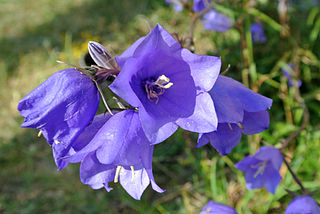
Campanula is one of several genera of flowering plants in the family Campanulaceae commonly known as bellflowers. They take both their common and scientific names from the bell-shaped flowers — campanula is Latin for "little bell".

The family Campanulaceae, of the order Asterales, contains nearly 2400 species in 84 genera of herbaceous plants, shrubs, and rarely small trees, often with milky sap. Among them are several familiar garden plants belonging to the genera Campanula (bellflower), Lobelia, and Platycodon (balloonflower). Campanula rapunculus and Codonopsis lanceolata are eaten as vegetables. Lobelia inflata, L. siphilitica and L. tupa and others have been used as medicinal plants. Campanula rapunculoides may be a troublesome weed, particularly in gardens, while Legousia spp. may occur in arable fields.
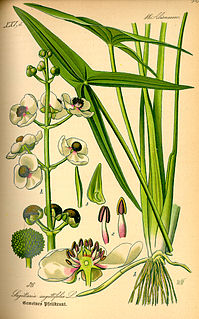
Sagittaria is a genus of about 30 species of aquatic plants whose members go by a variety of common names, including arrowhead, duck potato, katniss, Omodaka, swamp potato, tule potato, and wapato. Most are native to South, Central, and North America, but there are also some from Europe, Africa, and Asia.

Allium canadense, the Canada onion, Canadian garlic, wild garlic, meadow garlic and wild onion is a perennial plant native to eastern North America from Texas to Florida to New Brunswick to Montana. The species is also cultivated in other regions as an ornamental and as a garden culinary herb. The plant is also reportedly naturalized in Cuba.
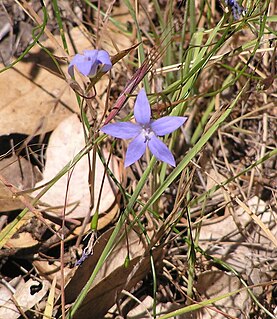
Wahlenbergia is a genus of around 260 species of flowering plants in the family Campanulaceae. Plants in this genus are perennial or annual herbs with simple leaves and blue to purple bell-shaped flowers, usually with five petals lobes. Species of Wahlenbergia are found on all continents except North America, and on some isolated islands, but the greatest diversity occurs in the Southern Hemisphere.
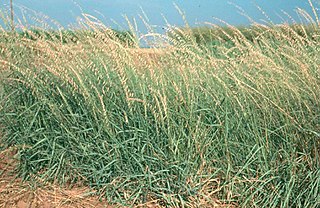
Bouteloua is a genus of plants in the grass family. Members of the genus are commonly known as grama grass.

Bouteloua dactyloides, commonly known as buffalograss or buffalo grass, is a North American prairie grass native to Canada, Mexico, and the United States. It is a shortgrass found mainly on the High Plains and is co-dominant with blue grama over most of the shortgrass prairie.

Blephilia, the pagoda plant or wood mint, is a genus of three species of flowering plants in the family Lamiaceae. They are all herbaceous plants native to eastern North America. Blephilia are most often found in open areas, glades, and mesic forests. All species of Blephilia are considered threatened or endangered in some states.

Lysipomia is a genus of flowering plants in the family Campanulaceae. They are cushion-like mountain plants all endemic to the high Andes. The genus is monophyletic.

Quercus buckleyi, commonly known as Texas red oak or Buckley's oak, is a species of flowering plant. It is endemic to the southern Great Plains of the United States.

Quercus rugosa, commonly known as the netleaf oak, is a broad-leaved tree in the beech and oak family Fagaceae. It is native to southern North America.

Nemacladus is a genus of flowering plants in the bellflower family known generally as threadplants. Species are native to the southwestern United States and northern Mexico. These are annual herbs with very slender, sometimes threadlike, branching stems bearing small five-lobed flowers.
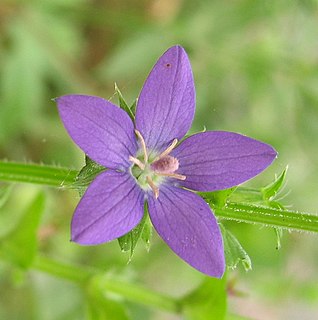
Triodanis perfoliata, the clasping Venus' looking-glass or clasping bellflower, is a flowering plant belonging to the family Campanulaceae. It is an annual herb native to North and South America, the natural range extending from Canada to Argentina. It is also naturalized in China, Korea and Australia.
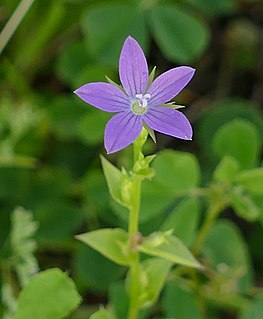
Triodanis biflora is a species of flowering plant native to the Americas and known commonly as small Venus' looking-glass. The flower is solitary and has a bell-shaped blue or purple corolla. Its leaf arrangement is alternate and its leaf type is simple. Its leaves are thin, serrate and sessile.
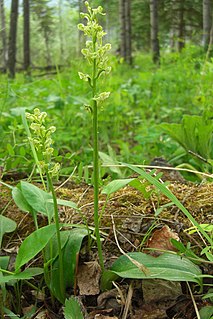
Platanthera obtusata, common name blunt-leaved orchid or small northern bog orchid, is a small species of orchid in the genus Platanthera. It widespread across much of the colder regions of the Northern Hemisphere, though rare in some parts of its range. Two subspecies are recognized:

Legousia is a genus of flowering plants in the family Campanulaceae, native to Europe. Species in the genus used to be placed under genus Specularia along with plants in genera Triodanis and Heterocodon as well as some species in genus Campanula. However, the division has been confirmed evolutionarily comprehensive by a Campanulaceae phylogeny based on DNA molecular evidence.

Anchistea is a genus of leptosporangiate ferns in the family Blechnaceae. It has only one species, Anchistea virginica the Virginia chain fern, which has long creeping, scaly, underground stems or rhizomes giving rise to tall widely separated, deciduous, single leaves. In contrast, the leaves of Osmundastrum cinnamomeum, which can be mistaken for A. virginica, grow in a group from a crown. Also in contrast to O. cinnamomeum the leaves are monomorphic without distinct fertile fronds. The lower petiole or stipe is dark purple to black, shiny and swollen, the upper rachis is dull green. The leaf blade is green and lanceolate, composed of 12 to 23 paired, alternate pinnatifid pinnae. The pinnae are subdivided into 15 to 20 paired segments that are ovate to oblong. The lower rachis is naked for about half its length. The sori or spore-producing bodies are found on the underside of the pinnae and are long and form a double row which outlines the major veins of the pinnae. In common with all ferns, A. virginica exhibits a gametophyte stage in its life cycle and develops a haploid reproductive prothallus as an independent plant. The spores are produced in red-brown sori which line the spaces (areolae) between the costa and costules. Further photographs can be found at the Connecticut Botanical Society and Ontario Ferns websites.
Diastatea is a genus of plants native to Latin America, mostly in Mexico and Central America but with one species extending southward along the Andes to Argentina.
- Diastatea costaricensisMcVaugh - Guatemala, Honduras, Nicaragua, Costa Rica
- Diastatea expansaMcVaugh - central Mexico
- Diastatea ghiesbreghtii(Kuntze) E.Wimm - southwestern Mexico
- Diastatea micrantha(Kunth) McVaugh - widespread from central Mexico to the Jujuy region of northern Argentina
- Diastatea tenera(A.Gray) McVaugh - southern Mexico and Guatemala
- Diastatea virgataScheidw. - southern Mexico

Musschia is a genus of plants in the family Campanulaceae. It contains three known species, all endemic to the Madeira Archipelago in the eastern North Atlantic, part of the Republic of Portugal. The genus is named in honour of Jean-Henri Mussche (1765-1834), the head gardener of the botanical garden in Ghent.

Triodanis leptocarpa, commonly called slimpod Venus' looking-glass, is a species of flowering plant in the bellflower family (Campanulaceae). It is native to the United States, where it is found primarily in the Great Plains and Midwest. Its natural habitat is in dry upland prairies and open rock outcrops. It is tolerant of disturbance and can be found in pastures and roadsides.



















